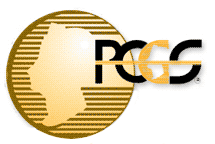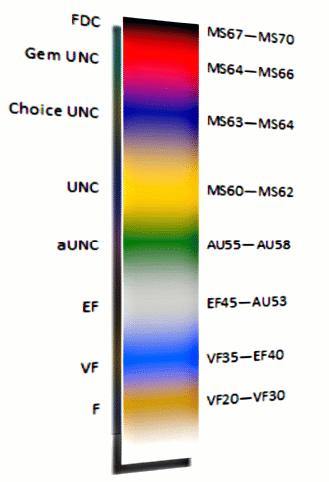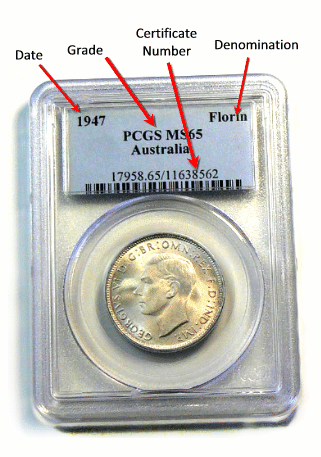By using this website, you are giving us consent to collect information and use cookies to improve your customer experience. For more information about data privacy, please visit our data privacy page.

The Professional Coin Grading Service (PCGS) is an independent and experienced grading company that authenticates and grades coins. The company has been grading coins for decades, is listed on the NASDAQ through its holding company Collectors Universe Inc., and has built a reputation on consistent and independent grading. Since 1985, they have graded almost 41 million coins, worth billions of dollars, and their grading certificates are respected all over the world.
Why buy PCGS-graded coins?
Ever bought a coin in one grade, only to be told by a professional that it was overgraded, and that it's only worth half of what you paid? By buying PCGS-graded coins, you know that the grade assessment was provided by at least two full-time coin graders who have the experience and know-how to assess the grades of your coins. More importantly, these graders aren't trying to sell you the coin. This means they have no incentive to deceptively overgrade them! Better still, PCGS doesn't grade harshly cleaned coins, so you know a PCGS graded coin is in original, uncleaned condition. On top of that, PCGS also authenticates coins, so if you see a 1923 halfpenny graded by PCGS, you know with certainty that the coin came from the mint and not a counterfeiter's workshop.
What grading system does PCGS use?
PCGS uses the Numerical Grading System. The Numerical Grading System is a modern grading system based on numbers instead of words. The higher the number, the higher the coin’s grade. Seventy is the highest grade. One is the lowest grade. Grading with numbers does away with deceptive, misleading, and confusing adjectival (word-based) grading.
However, before buying a PCGS graded coin, it is important to understand how the Numerical Grading System compares to the Australian adjectival system, as the standards aren't the same. You see, it's a common misconception that VF20 is the same as Very Fine, EF40 is the same as Extremely Fine, and AU50 is the same as about Uncirculated, and so on. This is not true. For technical reasons, grades are defined differently under the Numerical System, meaning that a coin graded EF40 shares the same characteristics as a coin graded Very Fine or thereabouts, and a coin in AU50 is more like what we call Extremely Fine or thereabouts. This doesn't mean the Numerical Grading System is lax, or that PCGS doesn't know how to grade. It means that the Numerical Grading System, and PCGS, grade by different grading standards. Calling EF40 the same as Extremely Fine is like saying ten meters is the same as ten yards, just because the number is the same!
Above is a diagram showing how the current grading system and the Numerical Grading System compare. I've used the blending colours to show that this comparison isn't exact, and that there can be sliding up or down a grade based on the series or type of coin you're looking at.
Your average UNC would make MS61 or MS62, while UNC coins with a few marks and scuffs would make MS60. In MS63 or 64, you'd be looking at around CHU or Gem UNC, while anything in 65 or 66 would easily make Gem UNC under the current system.
How can I tell if a coin has been graded by PCGS?
Once a coin has been graded, it is sonically sealed into a chemically non-reactive and durable case. Sealed along with it is the coin's grading certificate, as well as a barcode number, which you can use on the PCGS website to see the coin's details. Once the coin is sealed in, you can't change the certificate or damage the coin. More importantly, the holder will preserve the coin and is great for long-term storage. It also prevents collectors from inadvertently damaging a coin by touching it.
On your right is an example of what a typical PCGS holder looks like. All the important details of the coin are printed on the certificate, as well as the traceable barcode number. There is a security hologram on the back of the holder for added security and protection.
The verdict?
Today, with internet, email, and online auctions, coin grading has never been more important. There are hundreds of dealers and thousands of hobby sellers across the country. Some of them grade well. Some don't. And all grade to their own standards, based on their experience and know-how. So how do you separate the wheat from the chaff? And if you want to buy a coin from a dealer you've never dealt with, how can you trust his grading skills? How do you know he doesn't tamper with or clean his coins behind the scenes, far away from the unsuspecting customer's eyes? And if you're buying from a hobbyist online or from the newspaper, how do you know that the coin is even genuine?
Now, imagine for a moment if every quality coin in the market was graded and certified by PCGS. One day, you're browsing the catalogue of your friendly local dealer and you see a 1923 halfpenny, graded by PCGS as VF30. Since you've read PCGS' grading standards and are familiar with their grading system, you know exactly what you're getting. Even if you've never dealt with that particular dealer before, you can buy from him or her with confidence because you know their PCGS-graded coins are not cleaned, doctored, or repaired. You're also confident their coins are genuine. And most importantly, you know that their coins are graded to the same consistent standard as the rest of the PCGS-graded coins in the market.
Buying and selling coins has never been easier!
If you'd like to get your coins graded by PCGS, visit this link for more details.

 Change website currency
Change website currency 

